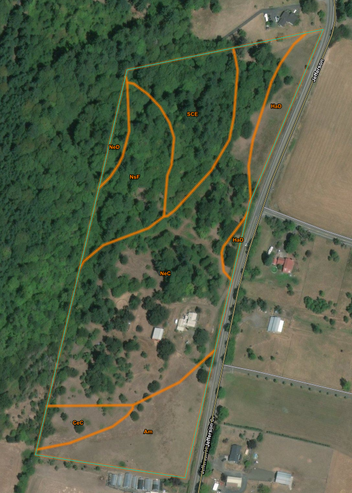Rosemary LoganCheckout the Spring 2020 section of NAU's two-semester Permaculture Design Course Blog! Archives
December 2023
Categories |
Back to Blog
By Abby Lundberg Over the past two years, my brother Jeremy and his wife Casey have worked hard to set up a permaculture-based orchard on their land near Salem, Oregon. I want to share some of the big picture site-mapping information about their land and showcase a little of the tremendously beautiful space they're cultivating. About the property: features, soil, and zones This aerial image from the USDA Web Soil Survey Tool shows that the main portion of the property under cultivation is predominately either classified as “NeC” (Nekia silty clay loam; big section in the middle where the buildings are) or “Am” (Amity silt loam; bottom right corner). Amity silt loam, which covers most of the pastureland, is terraced land that retains water, while Nekia silty clay loam is well-drained soil that occurs on the footslope of hills and has a layer of clay under the soil. The differences in how well the soils drain and how much clay they have impacts what kinds of plants grow. For instance, there are no trees in the the Amity silt loam section, perhaps because the trees (oaks in particular) don’t tolerate standing water very well. I’ve noticed that there is a wider variety of grasses in the “Am” section than on the dry slopes above; this seems to suggest the grasses in this area are adapted to somewhat-marshy climates.
 Zone 1 is the area that gets the most foot traffic and immediately surrounds the house, woodshed, and garage, while Zone 2 includes the front yard and barn. Zone 3 is predominately the orchard (though there are times when the orchard is probably also Zone 2 because of the amount of work it requires). Zone 4 includes pastureland, and Zone 5 is mostly forested areas that don’t see much traffic (unless it’s blackberry season). So what does it look like? (Spring 2020)Most of the plants are still pretty young, so especially at this time of year it can be hard to even spot the trees over the grass and flowers! The orchard rises up a soft slope with trees planted into hugelkultur mounds that follow the contours of the land. An annual ground cover mix fills the space between rows. Among the fruit trees there are a variety of small bushes, and flowers like California Poppies, Borage, and Dame's Rocket. (Dame's Rocket is invasive, but so are we! I won't hold that against it. It feeds butterflies and can be eaten by people.) Looking toward zone 1 (house) and zone 2 (barn and yard) from the orchard. This is close to the top of the orchard slope, and this height is where the soil type changes to NeC and oak trees grow, such as the very large one on the right in the first picture. The second photo shows the edge of the chicken house, a raised bed for strawberries, and tires with tomatoes planted in them that have a cattle panel for the tomatoes to be tied to as they grow. Looking down the orchard rows doesn't look like much, but the trees are still small. Someday they will grow big enough to obstruct the beautiful view!
1 Comment
Read More
Kristy Morgan
8/30/2021 09:53:41 am
My daughter and I want to get land and start a food forest. I have a strong desire and passion for the food forest, but have a lot to learn. I am curious if you have anything that I could do to help and learn with your team.
Reply
Leave a Reply. |
 RSS Feed
RSS Feed






